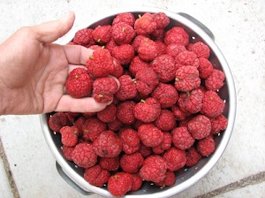Fruit Facts from
the
California Rare Fruit Growers, Inc.
Fruit of the Month: Che
Cudrania tricuspidata
Bur. ex Lavallee
Moraceae

The che is native to many parts of eastern Asia from the Shantung and
Kiangson Provinces of China to the Nepalese sub-Himalayas. It became
naturalized in Japan many years ago. In China, the leaves of the che
serve as a backup food for silkworms when mulberry leaves are in short
supply. The tree was introduced into England and other parts of Europe
around 1872, and into the U.S. around 1930.
The che requires minimal care and has a tolerance of drought and poor
soils similar to that of the related mulberry. It can be grown in most
parts of California and other parts of the country, withstanding
temperatures of -20° F.
Che are deciduous trees which can eventually grow to about 25 ft. in
height, but often remains a broad, spreading bush or small tree and can
be kept to a height of 6-8 feet with pruning. Immature wood is thorny
but loses its thorns as it matures. Female trees are larger and more
robust than male trees. Osage orange is sometimes used as a rootstock
because che on its own roots can sucker badly. Osage orange as a
rootstock for che gives you a plant that is more easily trained as a
standard, single-trunked shrub or small tree.
The che is dioecious, with male and female flowers on different plants.
Appearing in June, both types of flowers are green and pea-sized. The
male flowers turn yellow as the pollen ripens and is released, while
the wind-pollinated female flowers develop many small stigmas over the
surface of the immature fruit. Male plants occasionally have a few
female flowers which will set fruit.
Like the related mulberry, the che fruit is not a berry but a
collective fruit, in appearance somewhat like a round mulberry crossed
with a lychee, 1 to 2 inches in diameter. The ripe fruits are an
attractive red or maroon-red color with a juicy, rich red flesh inside
and 3 to 6 small brown seeds per fruit. While still firm they are
almost tasteless, but when fully soft ripe they develop a
watermelon-like flavor that can be quite delicious. The sugar content
is similar to that of a ripe fig. The fruit have a fairly long season
ripening in October and into November.
Sweet-Hot Che
Jam
Spicy jams are all the rage today, with one of them winning the Grand
Prize at the 2003 Scovie Awards. The recipe below is great on biscuits,
toast and pancakes, and you can even use it as a glaze on grilled meats
or as a topping for vanilla ice cream.
3 cups Che
2 cups water
1 package powdered fruit pectin
1 tablespoon red chile powder
1 cup sugar (or more to taste)
Crush the Che berries thoroughly in a bowl and then transfer to a
saucepan. Add the water and fruit pectin. Stir until the pectin is
dissolved. Add the chile powder and stir. Heat to boiling. Boil 5 to 10
minutes. Add the sugar and stir until dissolved. Boil 3 to 5 minutes,
stirring frequently, or until thick. Allow to cool, place in sterile
jars, and refrigerate.
Yield: About 1 1/2 cups
Heat Scale: Medium
Back to
Che Page
|
© Copyright 1997, California Rare Fruit Growers, Inc.
|